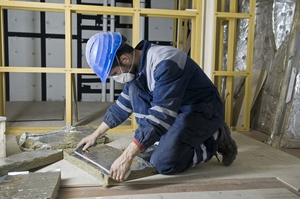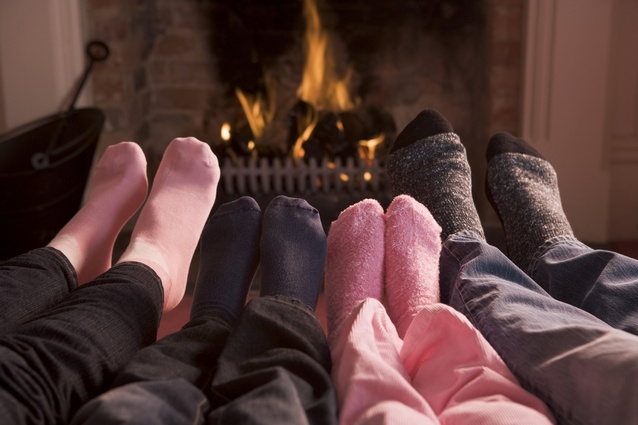Keeping warm: insulation, ventilation and heating in homes
We’ve all seen the ads on television on how important it is to insulate, ventilate and heat our homes. One of the biggest challenges for designers and builders, however, is finding the most cost effective way of delivering the next generation of buildings.
It is estimated that without adequate ceiling insulation, 42 percent of household heat is lost through the roof. Walls account for around 24 percent of heat loss and 10 percent of heat is lost through floors. More than 75 percent of New Zealand homes have insufficient ceiling insulation and 70 percent of homes where floor insulation can be installed, have no underfloor insulation. Add all that up and it’s easy to see why installing insulation makes sense.
Installing thermal insulation makes economic sense too. BRANZ research has shown that retrofitting ceiling insulation alone into an average uninsulated Wellington house of 150sq m would pay for itself in only four years, and after 20 years have provided a net benefit of over $3000. Reducing heat loss isn’t the only positive gain though – insulation can also help to reduce mould growing on walls and ceilings, making a healthy and safe environment to live in.
A Wellington School of Medicine study found that people in insulated homes had fewer medical and hospital visits for respiratory conditions, and fewer days off work and school. And, in a 2006 survey of people living in homes that had been retrofitted with insulation, 38 percent reported health benefits such as reduced incidence of asthma among children. It is important to be up-to-date with the current regulations regarding retrofitting insulation, particularly in external walls.
 Roof and underfloor insulation retrofits are generally exempt from building consents but retrofitting insulation into an external wall cavity is not. It will require a consent or specific approval from a building consent authority. The rationale behind this is that retrofitted insulation may affect moisture transfer inside timer framed walls and change drying rates, which in turn may cause moisture to accumulate and affect the durability of timber framing and cladding.
Roof and underfloor insulation retrofits are generally exempt from building consents but retrofitting insulation into an external wall cavity is not. It will require a consent or specific approval from a building consent authority. The rationale behind this is that retrofitted insulation may affect moisture transfer inside timer framed walls and change drying rates, which in turn may cause moisture to accumulate and affect the durability of timber framing and cladding.
Modernisation is seen by the government as an important part of improving the quality of New Zealand’s housing stock quality. If the home was built prior to 2000 then it will qualify for a subsidy of up to $1300 towards installing insulation and efficient heating systems. Those involved in renovating or retrofitting homes should provide clients and homeowners with advice and information on installing insulation and heating and ventilation systems, and use products that have a high R-Value rating. The higher the better.
For new builds, the opportunities to incorporate sustainable and energy efficient systems are considerably better and depending on the budget, the sky’s the limit in terms of materials and products. But it doesn’t have to cost the earth. New technologies and research make it much easier these days to design new homes using energy modelling and materials that utilise thermal mass and passive solar design. Double glazing coupled with high spec framing will significantly reduce heat loss in a home, for example, as well as reducing condensation.
Ironically, windows are also the best way to collect heat – by allowing sunlight in to heat up a concrete floor and creating thermal mass – so efficient window design has become an important aspect of new house design. Distributing the heat generated in a home – whether it’s a new build or an old home – can be assisted by the use of mechanical ventilation systems. In a well-designed home, the use of these systems will be limited and only come in to play in either very cold or very warm conditions.
In large homes, it may be more efficient to heat just a few rooms rather than the whole house, but again, if it’s well-designed then this shouldn’t be a problem. The reality is, though, that most average homes in New Zealand are poorly insulated and heated.
Sustainability touches all aspects of construction these days and one of the biggest challenges for designers and builders is finding the most cost effective way of delivering the next generation of buildings. Construction professionals need to get their heads around sustainability planning requirements, building regulations, environmental rating methodologies, budgetary requirements and understanding building physics.
They have to balance these requirements and come up with the most client friendly and cost effective package if they want to stay in business. Additionally, homeowners want assurances of structural integrity of work done on their homes and the durability of materials and products used, mainly as a result of the leaky building experience. Insulation is just one aspect of creating a healthy home. Good heating and ventilation go hand-in-hand with insulation. There are many choices available and sometimes builders and designers are unsure which option is best for their clients, but ideally a complete heating and ventilation system should be designed for each home.
The Building Code (Clause G4) requires ventilation with outdoor air to maintain air purity. Compliance documents contain several solutions for achieving this. The main solutions are natural ventilation comprising 5 percent of the floor area in opening devices or mechanical ventilation to achieve an air change in the occupied spaces (such as living areas) every three hours. There are two main types of ventilation systems – positive pressure or forced air ventilation systems and balanced pressure or heat exchanger ventilation systems.
Positive pressure or forced air ventilation systems work by blowing drier air into your house from the roof space above the ceiling or, in some types, from outside. They suit older houses with wooden joinery better than modern houses with sealed aluminium joinery – unless windows are opened or additional vents fitted. Because domestic ventilation systems draw air from the roof space, they are not directly drawing air from outside.
Consequently they cannot be used to comply with the Building Code ventilation provisions. However, Building Code compliance is not usually an issue because domestic ventilation systems are installed in addition to opening windows. Research carried out by the University of Otago in May 2011 found that the majority of the time, it was calculated that pumping air from the roof space into the house would provide no heating or cooling benefit. In fact, this would often actually act to push the internal temperature further away from the desired level rather than closer to it.
 Balanced pressure or heat exchanger ventilation systems extract warm damp air from living spaces and pass it through a heat-exchanger to heat up dry air which the system brings in from outside. This can fully meet Building Code requirements. They work best in more airtight, modern homes. Installing domestic ventilation systems needs special care. The roof space must be clean and dry, as any animal waste, pathogens, allergens, mould and fungi in the roof space may be ventilated into the living space of the house. It is important to check for leaks in the roof space, as these may contribute to fungal and bacterial growth.
Balanced pressure or heat exchanger ventilation systems extract warm damp air from living spaces and pass it through a heat-exchanger to heat up dry air which the system brings in from outside. This can fully meet Building Code requirements. They work best in more airtight, modern homes. Installing domestic ventilation systems needs special care. The roof space must be clean and dry, as any animal waste, pathogens, allergens, mould and fungi in the roof space may be ventilated into the living space of the house. It is important to check for leaks in the roof space, as these may contribute to fungal and bacterial growth.
Choosing the best option depends on the design of the house, its floor area, the location, how much sun the house gets, the type of roof … even the local climate. For best results, a system should be designed specifically for the house. Heating choices vary widely and again it will come down to cost, coupled with how the house is designed. Options include either portable gas or electrical heating such as fan, oil and radiant heaters through to fixed heaters such as heat pumps and panel heaters.
Heat pumps are generally used for heating (and cooling) larger areas. Usually they are able to remove moisture and have a remote control for easy operation. They require installation by a registered electrician. Panel heaters are wall mounted and can provide an affordable, economic solution for heating smaller rooms like bedrooms and hallways. Gas fires provide fast heat and are neat and tidy.
Look for a gas fire with a good energy (star) rating. A good rating means that you will require less energy to heat the room to an optimum temperature which means lower running costs.
Wood fires create a wonderful atmosphere in the room, but older fireplaces in particular are not very energy efficient. If a new fire is being installed, make sure you consult with the local council for the current requirements and permits.
Heat transfer kits are an efficient way of sending excess heat from one room in the house to as many as three other rooms. They use a fan and insulated ducting to transfer heat quietly through your ceiling cavity. A heat transfer kit will move excess heat from the room where your main heat source is located, such as a fire in the lounge, to warm up colder parts of your house that may not have a heat source.
The Building Code sets the minimum building standards (with an emphasis on ‘minimum’) and since 2008 the H1 building requirements have certainly improved standards in energy efficiency over the past few years.
Some would argue, however, that the minimum standards in relation to healthy homes and energy efficiency is still too low in New Zealand and designers and builders alike should be striving to exceed the minimum standards whenever possible.










